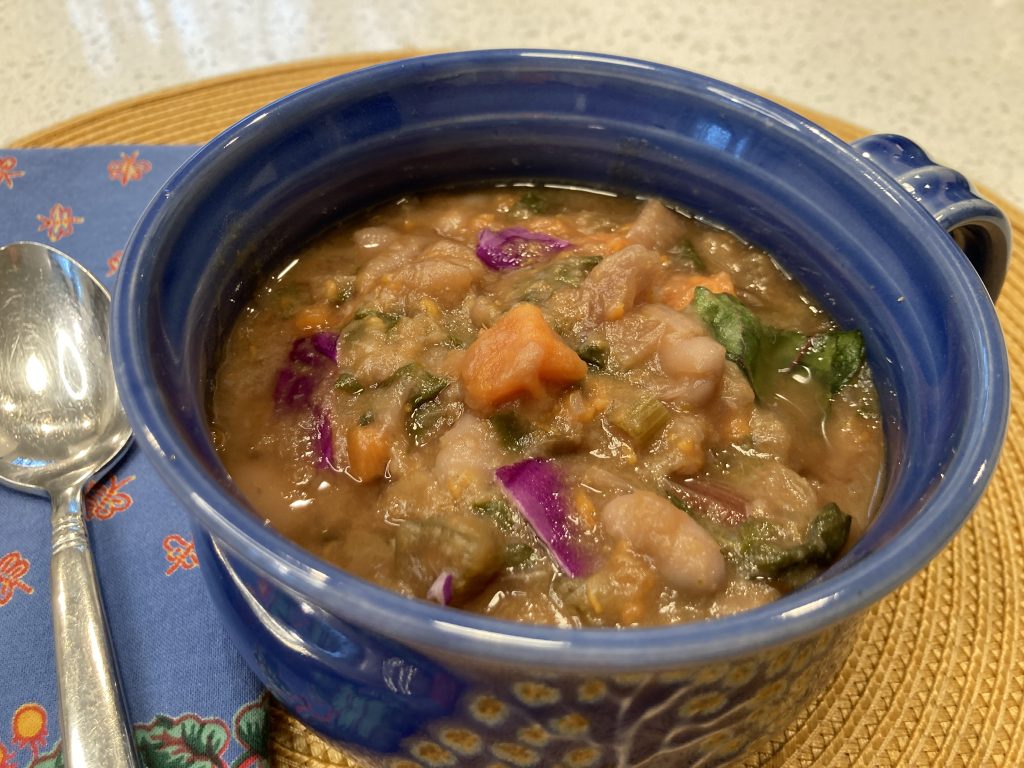CANNELLINI CABBAGE SOUP
Preparation Time: 75 to 90 minutes
Serves 4 to 6
For an Instant Pot, Standard Pressure Cooker, or Standard Pot
If you don’t tolerate or like beans, you can make this dish by cooking the vegetables in stock and serving over quinoa or millet to add some vegan protein to your meal. Hard beans are always easier to digest if soaked in water for 8 to 12 hours before cooking. They are also easier to digest if you add a pinch of gluten-free asafetida in the cooking process. Beans cook much faster in a standard pressure cooker or Instant Pot on a pressure setting. For creamier beans, it’s always best to add the salt (or the salted stock) after they’ve cooked instead of before.
1 cup dried cannellini or another white bean
1 small red cabbage
1 medium or large sweet onion
2 tablespoons avocado oil or coconut oil
2 or 3 fennel stalks or 1 large celery stalk
3 or 4 leaves red Swiss chard with stems, or other greens
1 large sweet potato
1 fresh or dried bay leaf
1 to 2 tablespoons favorite fresh herbs combined, such as rosemary, thyme, or basil
2 teaspoons freshly grated ginger
2 cloves pressed garlic
¾ teaspoon ground cumin
¾ teaspoon ground coriander
½ teaspoon ground turmeric
⅛ teaspoon ground asafetida (optional)
½ to 1 teaspoon balsamic vinegar
2 to 3 teaspoons mineral salt
1. Soak the beans in water for 8 to 10 hours. When ready to cook, strain the beans and rinse three times. Strain them again and add the beans to a pressure cooker, Instant Pot, or standard pot for stovetop cooking.
2. Chop the cabbage into bite-sized pieces and add 4 cups of the cabbage to the pot with 5 cups water. Bring to high pressure in a pressure cooker; then remove from the heat and let the pressure release naturally. In an Instant Pot, cook on high pressure for 12 minutes followed by a natural pressure release. In a standard pot, also add the bay leaf, bring to a boil, reduce the heat to medium, and cover. Cook on a gentle boil for at least 1 hour, until the beans are completely tender.
3. While the beans and cabbage are cooking, dice an onion. Heat a sauté pan on medium heat, add oil and the diced onion. Once the onion turns golden, reduce the heat to low and slowly caramelize for 15 to 20 minutes, stirring periodically. (You could start this soup in an Instant Pot by sautéing the onion first; however, if you sauté the onion outside the pot, you will save about 10 minutes.) Wash and chop the fennel or celery and chard stems and leaves. Peel and dice the sweet potato (about 3 cups).
4. When the pressure releases on the pressure cooker and Instant Pot, add the bay leaf and chopped vegetables. In the pressure cooker, continue to cook without a seal or pressure until the vegetables are tender (about 15 minutes). If making the soup in an Instant Pot, reset the cooker to low pressure for 12 minutes. For the standard stovetop pot, add the chopped vegetables after the beans have been cooking for an hour, or until the beans are tender. Then cook the vegetables with the beans until tender—about another 15 minutes.
5. While the vegetables are getting tender, prepare the fresh herbs by rinsing, chopping (if necessary) and measuring. Peel and grate the ginger. Peel and press the garlic. Once you can open the Instant Pot the second time, add the herbs, ginger and garlic to the soup. For the other cooking methods, add the herbs once the vegetables are almost tender.
6. Add the cumin, coriander, turmeric, and asafetida to the onions and stir. Once the beans and vegetables are tender, add the spiced onions. If you enjoy a thinner soup, add another 1 or 2 cups of water or fresh stock, if available. Finish the soup with the salt and vinegar, both to taste. Stir well and serve on its own as a soup or over rice, millet, or quinoa, if you wish.
Avoid or reduce garlic and increase ginger.





